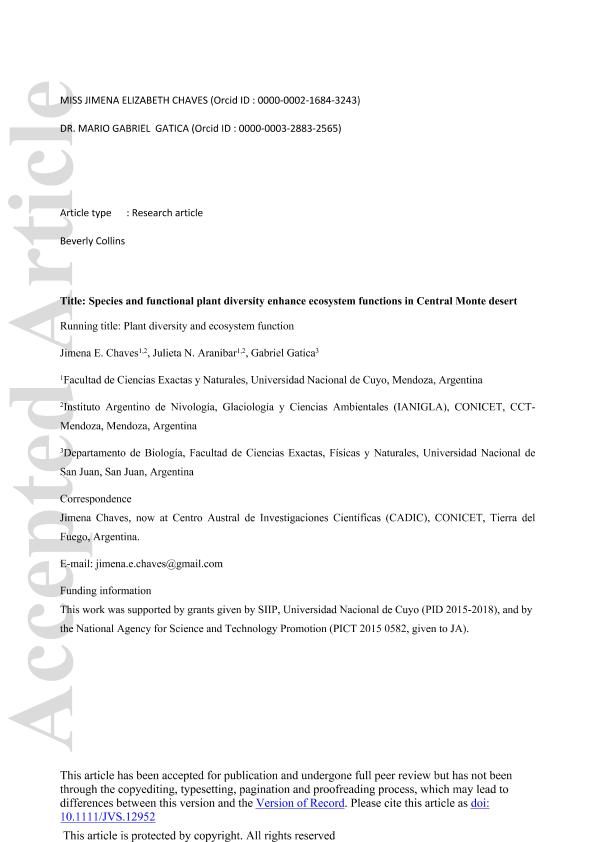Mostrar el registro sencillo del ítem
dc.contributor.author
Chaves, Jimena Elizabeth

dc.contributor.author
Aranibar, Julieta Nelida

dc.contributor.author
Gatica, Mario Gabriel

dc.date.available
2021-09-24T11:55:20Z
dc.date.issued
2020-09
dc.identifier.citation
Chaves, Jimena Elizabeth; Aranibar, Julieta Nelida; Gatica, Mario Gabriel; Species and functional plant diversity enhance ecosystem functions in the central Monte desert; Wiley Blackwell Publishing, Inc; Journal of Vegetation Science; 32; 4; 9-2020; 1-13
dc.identifier.issn
1100-9233
dc.identifier.uri
http://hdl.handle.net/11336/141432
dc.description.abstract
Questions: Niche complementarity has been proposed as the underlying mechanism for optimizing resource use of plants in diverse ecosystems, usually associated with their functional traits and not with the species number per se. Our main questions were: (a) does species diversity optimize the use of resources in arid ecosystems; (b) is there redundancy of species in the use of water and nutrients; and (c) what diversity components most affect ecosystem functions of water regulation and material cycling?. Location: Central Monte desert, Argentina. Methods: We selected vegetation patches with different species (SD) and functional diversities (FD), where we measured indicators of water regulation and material cycling. At two soil depths, we measured soil nitrate, phosphate, organic matter, chloride, electrical conductivity, and pH. We also determined decomposition, plant water use efficiency (foliar δ13C of C3 plants), and nitrogen use (δ15N). These variables were used as response variables, while total plant cover, species richness, Shannon, Simpson, evenness, and Rao's functional diversity indexes were used as predictors. Results: At the soil surface, response variables were better explained by models that included diversity (SD, FD or both) instead of evenness, total plant cover or null model. A diversity effect was not detected in deeper soil layers for most variables, except for electric conductivity, which had a positive effect on FD. Richness explained plant δ13C but had no influence on plant δ15N. Conclusions: Diversity of plant community influences ecosystem processes, as it increases decomposition, soil organic matter, and nutrient availability at the surface, and decreases water losses to the subsoil and plant water use efficiency. Both SD and FD explained one or more ecosystem processes of water regulation and material cycling, suggesting that individual species contribute to ecosystem functioning, with a low redundancy for arid areas.
dc.format
application/pdf
dc.language.iso
eng
dc.publisher
Wiley Blackwell Publishing, Inc

dc.rights
info:eu-repo/semantics/openAccess
dc.rights.uri
https://creativecommons.org/licenses/by-nc-sa/2.5/ar/
dc.subject
BIOGEOCHEMISTRY
dc.subject
DECOMPOSITION
dc.subject
ECOSYSTEM FUNCTION
dc.subject
FUNCTIONAL DIVERSITY
dc.subject
ISOTOPES
dc.subject
NITROGEN
dc.subject
PLANT DIVERSITY
dc.subject
SOIL
dc.subject
SOM
dc.subject.classification
Ecología

dc.subject.classification
Ciencias Biológicas

dc.subject.classification
CIENCIAS NATURALES Y EXACTAS

dc.title
Species and functional plant diversity enhance ecosystem functions in the central Monte desert
dc.type
info:eu-repo/semantics/article
dc.type
info:ar-repo/semantics/artículo
dc.type
info:eu-repo/semantics/publishedVersion
dc.date.updated
2021-09-06T20:01:43Z
dc.journal.volume
32
dc.journal.number
4
dc.journal.pagination
1-13
dc.journal.pais
Reino Unido

dc.journal.ciudad
Londres
dc.description.fil
Fil: Chaves, Jimena Elizabeth. Universidad Nacional de Cuyo. Facultad de Ciencias Exactas y Naturales; Argentina. Consejo Nacional de Investigaciones Científicas y Técnicas. Centro Científico Tecnológico Conicet - Mendoza. Instituto Argentino de Nivología, Glaciología y Ciencias Ambientales. Provincia de Mendoza. Instituto Argentino de Nivología, Glaciología y Ciencias Ambientales. Universidad Nacional de Cuyo. Instituto Argentino de Nivología, Glaciología y Ciencias Ambientales; Argentina
dc.description.fil
Fil: Aranibar, Julieta Nelida. Consejo Nacional de Investigaciones Científicas y Técnicas. Centro Científico Tecnológico Conicet - Mendoza. Instituto Argentino de Nivología, Glaciología y Ciencias Ambientales. Provincia de Mendoza. Instituto Argentino de Nivología, Glaciología y Ciencias Ambientales. Universidad Nacional de Cuyo. Instituto Argentino de Nivología, Glaciología y Ciencias Ambientales; Argentina. Universidad Nacional de Cuyo. Facultad de Ciencias Exactas y Naturales; Argentina
dc.description.fil
Fil: Gatica, Mario Gabriel. Universidad Nacional de San Juan; Argentina. Consejo Nacional de Investigaciones Científicas y Técnicas; Argentina
dc.journal.title
Journal of Vegetation Science

dc.relation.alternativeid
info:eu-repo/semantics/altIdentifier/url/https://onlinelibrary.wiley.com/doi/10.1111/jvs.12952
dc.relation.alternativeid
info:eu-repo/semantics/altIdentifier/doi/http://dx.doi.org/10.1111/jvs.12952
Archivos asociados
